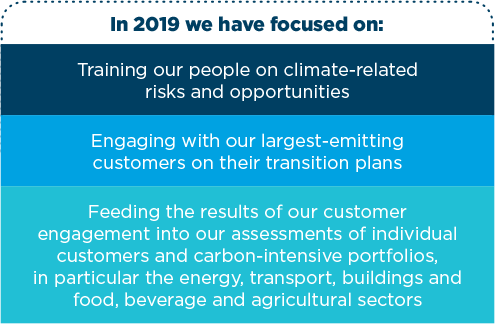Engaging with our customers on their transition plans
Throughout 2019 we have analysed the carbon disclosures of over 80 of our largest emitting customers and engaged with 29 of these to support them to establish, and where appropriate, strengthen existing low carbon transition plans.
This engagement will inform the development of a model applicable to our broader customer base enabling us to encourage customers to improve the management and disclosure of their climate-related risks and opportunities.
Within each industry our customers have different starting points. Both through customer discussions and reviews of public disclosures we are developing a better understanding of our customers’ preparation for, and management of, their most likely climate-related risks and opportunities. Insights we have gained from these customer conversations include:
Energy: our engagement in this sector is initially focused on customers with thermal coal operations. Some customers see continuing strong demand for high-quality, low-cost Australian thermal coal that will be used in recently built or planned
high efficiency, lower emissions (HELE) plants across Asia; their strategy is focused on developing high quality thermal coal assets and they are committed to improving their external disclosures. Other customers have undertaken scenario analysis (aligned with TCFD recommendations), revealing that some of their commodities perform worst under a low-carbon transition; in response they are directing limited expenditure to thermal coal and most of this is in maintenance capital rather than expansion. Some companies are also starting to work with
their suppliers and customers to seek to reduce the emissions associated with the use of their mining commodities, ie ‘Scope 3’ emissions.

Transport: a significant customer has ambitious plans to expand their electric vehicle fleet in Australia and is building a new distribution centre that will integrate rooftop solar and electric vehicle charging bays. They also plan to enter a renewable energy power purchase agreement (PPA) to lower their carbon footprint and shield themselves from price volatility.
Buildings: a number of customers have established net-zero carbon targets that will be achieved largely through improved energy efficiency and onsite solar installations, setting time bound goals to achieve this by 2030.
Food, beverage and agriculture: for many of our agribusiness and food producers, the physical risks of climate change (e.g., water availability and supply) represent the most material and immediate risk to their business, rather than transition risks. We have observed these customers are increasingly focused on managing climate-related risks by committing to reduce or remove deforestation from their operations and supply chains.
